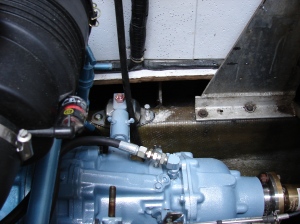Tags
I hesitated to bolt the engine down. It just didn’t feel right.
In a boat, the motor rotates the transmission that rotates the shaft that rotates the prop that pushes water aft that pushes the shaft forward that pushes on the transmission that pushes on the motor mounts that makes the boat move. Like all boats this vintage, the motor is attached to steel studs that are attached to rubber isolators that are attached to fiberglass-wrapped wood stringers with lag screws. Lag screws are just big screws with hex heads like bolts.
You can see the old fastener hole just to the right of the new fastener. I shifted the engine about two inches forward and repaired the old fastener holes.
Standard practice is to align the engine, then lag the mounts to the stringers, then adjust the alignment. Typically 3/8″ x 3 1/2″ lags are used, so you can adjust the engine position using the slop in the mount holes. I started with 3/8″ lags.
You can see how sloppy the whole thing is. When the lag loosens even slightly, the motor can move and lose alignment, causing noise and vibration and the shaft falling out of the boat.
I didn’t like it. So I switched to 4 1/2″ long 1/2″ lags in very tight 7/16″ holes. The bolts are tight in the motor mounts and tight in the 5/16″ thick fiberglass wrap around the stringers, so even if they loosen (relax) slightly, the shaft will push on the transmission will push on the mount will push on the stringer and nothing will move. Nothing.
Luckily, the preliminary alignment held while I installed the lags, and the engine is now perfectly aligned and very, very solidly mounted.
By the way, I used galvanized lags instead of stainless, even though they’re not as pretty. Two reasons: galvanizing sticks to wood like stink, and stainless fasteners don’t belong in tight, potentially wet holes. It’s all about crevice corrosion. Oxide layers and anaerobic conditions. Dude.



